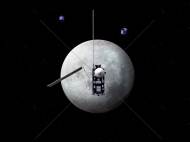Great HDTV videos from Japan’s lunar explorer KAGUYA
 KAGUYA (SELENE: SELenological and ENgineering Explorer) is Japan’s first large lunar explorer which was launched by the H-IIA rocket on September 14, 2007. Its mission regarding lunar exploration has been keenly anticipated by many countries as it represents the largest lunar exploration project since the Apollo program. The lunar missions that have been conducted so far have gathered a large amount of information on the Moon, but the mystery surrounding its origin and evolution remains unsolved.
KAGUYA (SELENE: SELenological and ENgineering Explorer) is Japan’s first large lunar explorer which was launched by the H-IIA rocket on September 14, 2007. Its mission regarding lunar exploration has been keenly anticipated by many countries as it represents the largest lunar exploration project since the Apollo program. The lunar missions that have been conducted so far have gathered a large amount of information on the Moon, but the mystery surrounding its origin and evolution remains unsolved.
KAGUYA investigated the entire moon in order to obtain information on its elemental and mineralogical distribution, its geography, its surface and subsurface structure, the remnants of its magnetic field and its gravity field using the installed observation equipment.
KAGUYA consisted of a Main Orbiter at 100km altitude and two small satellites, “OKINA” (Relay Satellite) and “OUNA” (VRAD Satellite), in polar orbit. The scientific instruments on board the Main Orbiter are used for the global mapping of lunar surface, magnetic field measurement, and gravity field measurement together with the instruments on the Relay Satellite and VRAD Satellite. The key technologies, such as the lunar orbit insertion and attitude / orbit control of the Orbiter are verified for future lunar exploration.
Then KAGUYA entered the lunar orbit after another one and a half times orbiting around the Earth. On September 29, KAGUYA obtained a moving image of the Earth taken with a high definition television camera from a point 110,000km away from the Earth. In the next video you can see the Earth by the KAGUYA HDTV (Tele-camera) during the penumbral lunar eclipse.
On October 4, KAGUYA successfully entered into lunar orbit with an apolune altitude of 11,741km. “OKINA” was separated on the orbit at an apolune altitude of 2,400km while lowering its altitude gradually on October 9, “OUNA” was separated on the orbit at an apolune altitude of 800km on October 12. The main orbiter of KAGUYA entered into the lunar polar orbit at an altitude of 100km on October 18 as scheduled.
KAGUYA was descended to the 50km altitude from February 1, 2009 and then was descended again to 10-30km in Lower altitude (Perilune) from April 16, 2009.
Finally, KAGUYA impacted at the south-east of near side of the Moon on June 10, 2009 thus ending its mission.
The results are expected to lead to a better overall understanding of the Moon’s origin and evolution. Further, the environment around the Moon including plasma, the electromagnetic field and high-energy particles will also be observed. The data obtained in this way will be of great scientific value and also be important information in exploring the possibility of utilizing the Moon in the future.









Good quality optics will still pick up stars, even on the light side of the moon because unlike earth, the moon has no atmosphere for the Hasselblaad optics to contend with!
I recently challenged JAXA to provide proof to us that their “Earthrise” pics are un-tampered..They chose not to reply and chose not to place my post up either!! The colour of the earth as portrayed in that sequence of pictures is impossible from that far out in space under the laws of physics!! It’s all BS!
You can find very interesting videos torrents on this site.